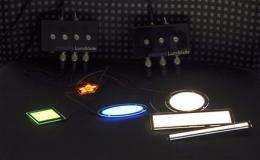A bright idea: Philips lets flat lights out of lab

(AP) -- Someday, our ceilings and walls might radiate light, illuminating indoor spaces as brightly and evenly as natural daylight.
Though that possibility remains years off, the Dutch electronics company Philips is letting people tinker with the technology that would enable it.
The world's biggest lighting maker has begun selling do-it-yourself kits with little glowing wafers called "Lumiblades." They come in red, white, blue or green for anyone who wants to pay nearly $100 per square inch.
It's one of the first chances people outside research labs have had to get their hands on lights made from organic light emitting diodes, or OLEDs.
The company's aim is to get designers, architects and other creative types thinking about how these flat lights can be used, and to start collaborating on early products.
General Electric Co., Siemens AG and Royal Philips Electronics NV, which are developing OLEDs, believe the technology will eventually be more efficient than traditional incandescent bulbs, energy-saving compact fluorescent lights and even the LED lights just now reaching the market.
OLEDs have a key advantage: They emit light evenly from a whole surface, rather than a single point. That eliminates the need for lampshades and other coverings that scatter light and protect eyes from glare. Creating light and then immediately shading it is an inefficient way of doing things, from an engineering standpoint.
For now, the Lumiblades are just small, flat lights - interesting in and of themselves.
"We believe that OLEDs have a lot to offer in terms of design, in terms of its beauty, in terms of light effects," said Dietrich Bertram, who heads Philips' OLED operations in Aachen, just across the border from Philips' home country, the Netherlands.
More than 100 of the Lumiblades kits have been sold since Philips began offering them in April, the company says. Buyers are mostly using them for prototyping, and plan to order larger numbers of customized OLEDs when they are ready to go to production.
Random International, a trio of London-based artists, used 1,024 Lumiblades to make an art installation called "You Fade to Light." As people walk past the structure, which is 2.7 meters (9 feet) wide by 1.3 meters (4.25 feet) high, a camera and computer turn off the lights on panels opposite the passers-by, mimicking their motion, like a giant monitor.
"Having worked with the OLEDs, I see it as far more of a material than a light source," said Hannes Kochs, one of the installation's designers. The diffuse light cast by the OLED panels makes them "stunning, and utterly different" from other kinds of light, he said.
Lumiblades run from about 70 euros ($100) for a small square to 500 euros ($700) for a piece the size of a mobile phone. The bigger the piece, the brighter it is.
When switched off, Lumiblades resemble small mirrors, with an aluminum backing inside two glass plates.
When switched on, a microscopic layer of organic material inside begins to emit light, and the Lumiblade glows. Only the faintest hint of warmth is perceptible.
This technology is early stage. Philips isn't trying to win prizes for presentation of the kits, which are sold online and come only with a simple wire. (The Lumiblades have to be plugged in, though battery-powered OLEDs are possible.)
"All the contents of this experience kit are engineering samples only and do not comply with existing lighting and safety norms," a manual included in the box says.
The company recommends buying a converter box and dimmers for an additional 70 euros to make sure users don't "overdrive" their panels. OLEDs have no bulb to blow, but cranking up the juice makes the lights burn brighter, and then wear out quicker.
When used at recommended currents, the lights in the kit are designed to last for 10,000 hours, at which point they will have faded to half of their original brightness. That compares with a life span of 1,000 hours for an incandescent bulb, and is about the same as the current generation of compact fluorescent lights.
The company says it sees interest from artists, architects, jewelers and some industrial applications where very even lighting is necessary. Separately, Philips and other companies are working with vehicle makers on using OLEDs in display panels, where their thinness and coolness would be valuable. TVs with OLED-based displays are also starting to emerge.
Philips eventually hopes to market window panes that are transparent during the day and emit light at night. Similarly, GE, which is developing cheap, flexible OLEDs encased in plastic, imagines a rollable, light-emitting window blind.
Bertram says his personal dream has been the same since he started working on OLEDs many years ago: "I really want to see the sun rise on my ceiling, even if it's dark and rainy outside."
---
On the Net:
Lumiblade site: http://tinyurl.com/dkmn4y
©2009 The Associated Press. All rights reserved. This material may not be published, broadcast, rewritten or redistributed.

















